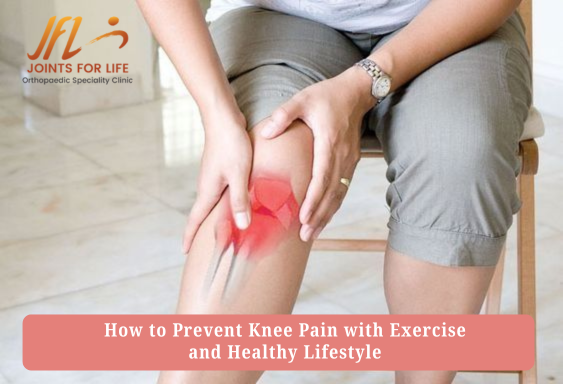Knee Pain in Your 30s & 40s: Why It’s Rising and How to Prevent It

Knee pain, once considered a problem of aging, has now become increasingly common among people in their 30s and 40s. Recent medical studies reveal that younger adults are experiencing early signs of joint damage, often without realizing it. Factors such as weight gain, sedentary lifestyles, and past sports injuries are among the main reasons behind this growing concern. Consulting a Knee Replacement Surgeon in Kharadi can help individuals understand how early diagnosis and proper care can prevent severe joint issues in the future.
Understanding the Changing Trends in Knee Pain
In recent years, orthopedic experts have observed a significant rise in knee-related complaints among middle-aged adults. Unlike the traditional belief that joint problems are confined to older generations, new data shows that cartilage damage and bone wear are now being diagnosed in individuals as young as 30.
The shift is largely attributed to lifestyle and environmental changes. Long working hours, minimal physical activity, and increasing reliance on digital devices have led to weak muscles and poor posture — both of which directly impact knee health. Additionally, the long-term impact of past sports injuries, especially among those who played high-intensity games in youth, continues to affect joint stability years later.
Key Causes of Knee Pain in the 30s and 40s
- Excess Body Weight Carrying extra weight places additional pressure on knee joints, accelerating the wear and tear of cartilage. Every step you take exerts two to three times your body weight on your knees. This constant strain can lead to inflammation and gradual joint deterioration.
- Lack of Physical Activity Sedentary lifestyles are among the biggest contributors to modern knee pain. Sitting for prolonged hours causes the muscles around the knees to weaken, reducing joint support. Over time, this weakness can lead to pain, stiffness, and reduced mobility.
- Old Sports Injuries Injuries sustained in early adulthood, such as ligament tears or meniscus damage, can resurface later in life. Even if they appeared to heal completely at the time, repetitive stress and natural aging can aggravate old injuries, leading to chronic discomfort.
- Improper Posture and Footwear Poor posture, uneven weight distribution, and inadequate footwear alter body alignment. This imbalance puts extra stress on the knee joints and accelerates degeneration. Footwear that lacks arch support or cushioning can worsen the condition.
- Genetic PredispositionSome individuals are genetically more susceptible to joint problems. If family members have experienced early knee issues or osteoarthritis, the likelihood of developing similar conditions increases significantly.
The Role of Obesity in Joint Health
Obesity is one of the strongest predictors of knee degeneration. Studies show that people with higher body mass index (BMI) are at greater risk of developing osteoarthritis at an early age. Excess fat not only adds mechanical stress but also releases inflammatory chemicals that damage cartilage tissue. Maintaining a balanced diet and incorporating daily movement can significantly lower the risk of developing chronic joint conditions.
Early Signs of Knee Problems You Shouldn’t Ignore
- Persistent pain or stiffness after sitting or standing for long periods
- Clicking, grinding, or popping sounds during movement
- Swelling or redness around the joint
- Difficulty climbing stairs or bending the knee fully
- A feeling of instability or the knee “giving out” suddenly
Understanding Early-Onset Osteoarthritis
Osteoarthritis, once associated with old age, is now increasingly affecting people under 45. It occurs when the protective cartilage between bones wears down, causing pain and reduced mobility.
The main reasons behind early-onset osteoarthritis include repetitive strain, obesity, and undiagnosed knee injuries.
While the condition is progressive, lifestyle changes and physiotherapy can slow its advancement. Early diagnosis helps avoid invasive procedures later in life.
Lifestyle and Exercise Tips for Healthy Knees
- Keep Moving Engaging in regular physical activity keeps joints flexible and muscles strong. Opt for low-impact exercises like cycling, swimming, or brisk walking. These help maintain mobility without adding excessive stress to the knees.
- Strengthen Supporting Muscles Strong leg muscles, particularly the quadriceps and hamstrings, act as shock absorbers for the knees. Incorporate light strength training and resistance exercises to improve joint stability.
- Practice Proper Posture Whether sitting or standing, maintaining good posture ensures even weight distribution. Avoid crossing your legs or sitting in the same position for extended periods.
- Choose the Right Footwear Shoes with cushioned soles and good arch support reduce stress on the knees. Replace worn-out shoes regularly and avoid high heels that alter your natural alignment.
- Balance Work and Movement If your job involves sitting for long hours, take short breaks to stretch or walk around every 30 minutes. Gentle movement prevents stiffness and keeps blood circulating to the joints.
Nutritional Support for Knee Health
- Omega-3 fatty acids (found in salmon, flaxseeds, walnuts) for reducing inflammation
- Vitamin D and calcium for bone strength
- Collagen and protein to rebuild connective tissue
- Antioxidant-rich fruits and vegetables to combat oxidative stress
Preventive Measures for Long-Term Knee Health
- Maintain a healthy body weight to minimize stress on your knees.
- Include flexibility exercises like yoga or stretching in your daily routine.
- Warm up before workouts and cool down afterward to protect muscles and joints.
- Avoid sudden or jerky movements during physical activities.
- Seek early medical advice if you experience recurring discomfort.
When to Seek Medical Help
Many people ignore knee pain until it becomes severe. However, early consultation with an orthopedic expert can prevent long-term damage. If your pain persists for more than two weeks, interferes with daily activities, or causes visible swelling, it’s crucial to undergo proper assessment. Imaging techniques like MRI or X-rays can detect early cartilage wear or ligament damage that might not be visible externally. Consulting a Knee Replacement Surgeon in Kharadi at the right time can help identify the root cause and ensure appropriate treatment before complications arise.
Long-Term Impact of Ignoring Knee Pain
Neglecting knee problems doesn’t just affect mobility — it can have broader health implications. Chronic pain can lead to reduced physical activity, weight gain, and even emotional stress. Over time, untreated joint issues can progress to advanced arthritis, leaving surgery as the only viable treatment option. Taking preventive measures early not only improves physical well-being but also enhances overall quality of life.
Conclusion
Knee pain among people in their 30s and 40s is no longer a rarity. Changing lifestyles, old injuries, and poor fitness habits are contributing to early joint deterioration. By maintaining an active routine, managing body weight, and practicing proper posture, individuals can protect their knees and reduce the risk of long-term damage. For those already experiencing chronic discomfort, consulting a Knee Replacement Surgeon in Kharadi ensures that potential joint issues are identified early, allowing for preventive care and improved mobility in the years ahead.
Protect your steps today — because every move you make today builds the foundation for pain-free living tomorrow.
Frequently Asked Questions (FAQs)
- What are the most common causes of knee pain in younger adults?
The main causes include weight gain, sedentary lifestyles, and old injuries from sports or accidents. Poor posture and weak leg muscles also play a major role. - Can exercise worsen knee pain?
Not all exercises are harmful. High-impact activities like running or jumping can aggravate pain, but low-impact exercises such as swimming or cycling are beneficial for joint health. - How can I strengthen my knees naturally?
Focus on building leg muscles through light strength training, stretching, and balance exercises. Maintaining good posture and wearing supportive shoes also helps. - Are knee problems reversible at an early stage?
Yes, with timely diagnosis, physical therapy, and lifestyle modifications, early knee issues can be managed or reversed before they become severe. - What foods help reduce knee inflammation?
Omega-3-rich foods like fish and walnuts, as well as antioxidant-packed fruits and vegetables, help reduce inflammation and support cartilage health.

